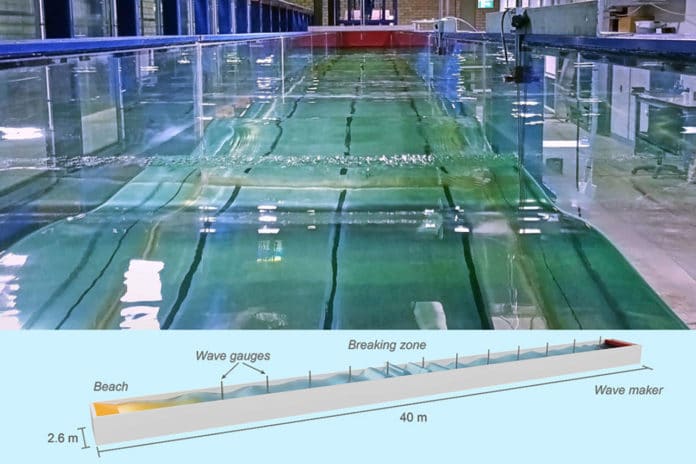Wave breaking is the main method for dissipating energy inputted into ocean waves by wind and transported across the spectrum by nonlinearity. It determines the properties of the sea state and is essential in ocean-atmosphere interactions, ocean pollution, and rogue waves. Due to its turbulent nature, wave breaking is too computationally demanding to solve via direct numerical simulations, even in simple, short-duration situations.
To overcome this challenge, MIT engineers have developed a new way to model how waves break. Using machine learning algorithms with data from wave-tank experiments, they tweaked equations traditionally used to predict wave behavior. They found that the model was more accurate than traditional wave equations in predicting a wave’s steepness right before breaking and its energy and frequency after breaking.
Scientists usually go with one of two approaches to predict the dynamics of a breaking wave. Those approaches include 1. Attempting to precisely simulate the wave at the scale of individual molecules of water and air. 2. Run experiments to try and characterize waves with actual measurements.
The first approach is computationally expensive and difficult to simulate even over a small area; the second requires a huge time to run enough experiments to yield statistically significant results.
The MIT team borrowed pieces from both approaches to develop a more efficient and accurate model for this new study. They begin with a set of equations considered the standard description of wave behavior. By training the model from actual experiments, scientists improved the model.
MIT postdoc Debbie Eeltink said, “We had a simple model that doesn’t capture wave breaking, and then we had the truth, meaning experiments that involve wave breaking. Then we wanted to use machine learning to learn the difference between the two.”
Experiments in a 40-meter-long tank were used to acquire wave-breaking data. The tank was fitted at one end with a paddle which the team used to initiate each wave. The paddle was set to create a breaking wave in the tank’s middle. As waves traveled down the tank, gauges along the length of the tank monitored the water’s height.
Eeltink said, “It takes a lot of time to run these experiments. You have to wait for the water to calm down between each experiment before you launch the next experiment completely. Otherwise, they influence each other.”
The team ran almost 250 experiments. The data from these experiments were used to train the machine-learning algorithm known as a neural network. Specifically, the algorithm is trained to compare the real waves in experiments with the predicted waves in the simple model. The algorithm tunes the model to fit reality based on any differences between the two.
After training their model, they introduced the model to entirely new data. In these tests, they found the updated model made more accurate predictions than the simple, untrained model, for instance, making better estimates of a breaking wave’s steepness.
The team reported, “The new model also captured an essential property of breaking waves known as the “downshift,” in which the frequency of a wave is shifted to a lower value. The speed of a wave depends on its frequency. For ocean waves, lower frequencies move faster than higher frequencies. Therefore, after the downshift, the wave will move faster. The new model predicts the change in frequency, before and after each breaking wave, which could be especially relevant in preparing for coastal storms.”
Eeltink said, “When you want to forecast when high waves of a swell would reach a harbor, and you want to leave the harbor before those waves arrive, then if you get the wave frequency wrong, then the speed at which the waves are approaching is wrong.”
The team’s updated wave model is in the form of an open-source code that others could potentially use, for instance, in climate simulations of the ocean’s potential to absorb carbon dioxide and other atmospheric gases.
Journal Reference:
- Eeltink, D., Branger, H., Luneau, C. et al. Nonlinear wave evolution with data-driven breaking. Nat Commun 13, 2343 (2022). DOI: 10.1038/s41467-022-30025-z
